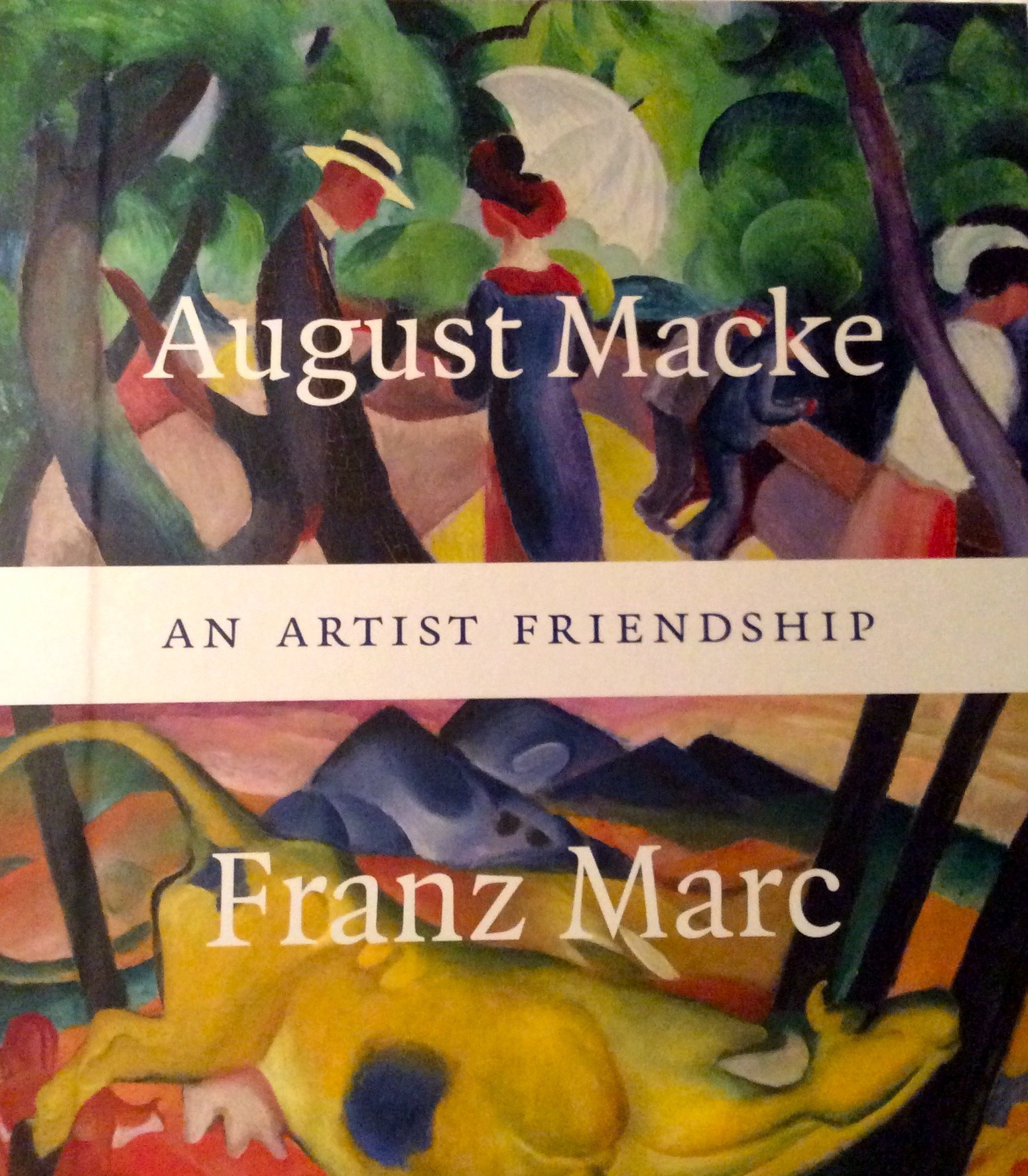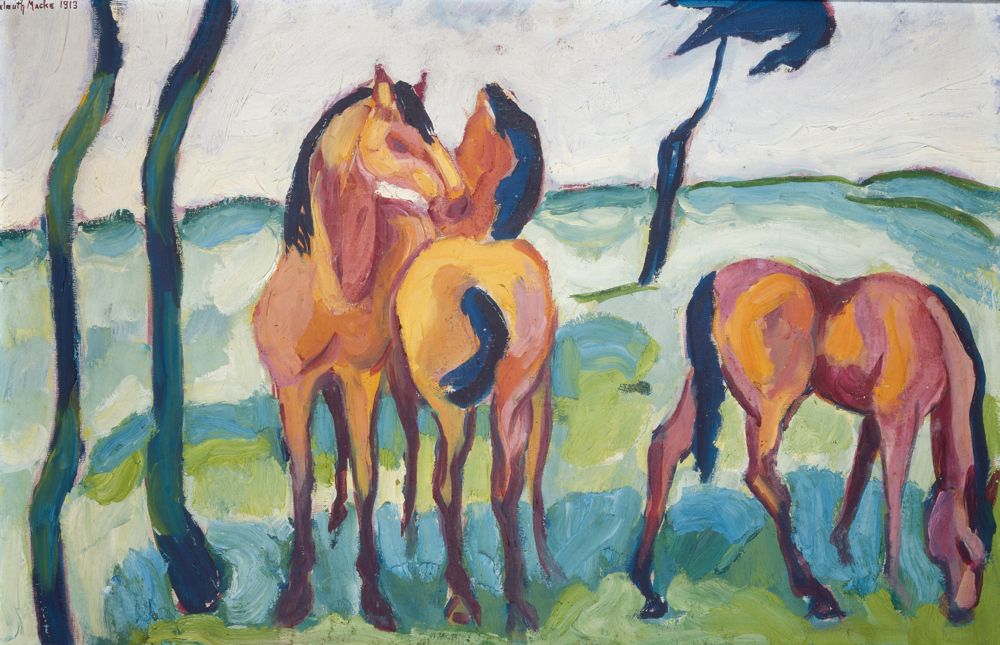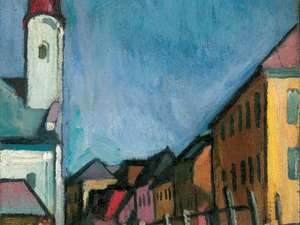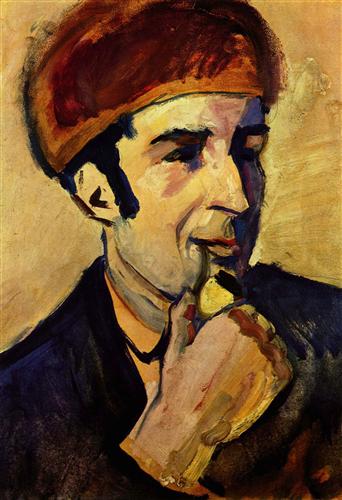
by Jean Marie Carey | 20 Jan 2017 | Art History, August Macke, Expressionismus, Franz Marc, German Expressionism / Modernism, Helmuth Macke
Book Review: August Macke and Franz Marc: An Artist Friendship
Catalog of an exhibition held at the Kunstmuseum Bonn, 25 September 2014 – 4 January 2015; and at the Städtische Galerie im Lenbachhaus und Kunstbau, Munich, 28 January – 3 May 2015; 359 pages with many color illustrations and black and white archival photographs.
I recently began doing some book reviews for Museum Bookstore, an online repository of catalogues and other printed material generated on behalf of museum and gallery exhibitions. My first review is of my favorite book of 2014-2015, the outstanding catalogue presented by the Lenbachhaus and Kunstmuseum Bonn in support of August Macke und Franz Marc: eine Künstlerfreundschaft. Please support this very worthy independent bookstore effort by checking out the companion text on the site.
§ § §
Published on 26 September 1914 to coincide with the 100th anniversary of the death of August Macke as well as the launch of the ambitious cooperative retrospective of Macke’s and Franz Marc’s overlapping oeuvres, the exhibition catalogue August Macke and Franz Marc: An Artist Friendship (August Macke und Franz Marc: eine Künstlerfreundschaft is its twin in the original German from which the English version has been translated) is, perhaps not surprisingly, a tour-de-force of editing and research. What is unexpected is that the editors, longtime Lenbachhaus Blaue Reiter curator Annegret Hoberg and Volker Adolphs of Kunstmuseum Bonn, along with a smartly-assembled team of university- and museum-based German art historians, bring to bear not just a wealth of knowledge but so much compassion to these essays, confronting directly the loss and sadness we naturally feel over the too-short lives of Marc and Macke. Macke, the extroverted Rhinelander, was killed in Champagne, France, at 27, while Marc, the contemplative Bavarian, died aged 36 at Verdun in the spring of 1916.
 Despite their frank sentimentality, the catalogue’s chapters and essays are impeccably scholarly. Hoberg’s “August Macke and Franz Marc / Ideas for a Renewal of Painting” and Adolphs’ “Seeing the World and Seeing Through the World / Nature in the Work of August Macke and Franz Marc” are classic art historiography based in peerless analysis. Hoberg focuses on the milieu of the international avant-garde that encouraged Marc and Macke to not only follow the careers of but become personally acquainted with the Parisian Orphist Robert Delaunay and the Italian Futurist Umberto Boccioni. While Marc’s primary subjects directly encompass animals and the pastoral, albeit reframed through a unique pantheistic realism, Macke, who often painted urban scenes, has a less direct relationship to “nature,” which Adolphs teases out, particularly in comparison to Marc.
Despite their frank sentimentality, the catalogue’s chapters and essays are impeccably scholarly. Hoberg’s “August Macke and Franz Marc / Ideas for a Renewal of Painting” and Adolphs’ “Seeing the World and Seeing Through the World / Nature in the Work of August Macke and Franz Marc” are classic art historiography based in peerless analysis. Hoberg focuses on the milieu of the international avant-garde that encouraged Marc and Macke to not only follow the careers of but become personally acquainted with the Parisian Orphist Robert Delaunay and the Italian Futurist Umberto Boccioni. While Marc’s primary subjects directly encompass animals and the pastoral, albeit reframed through a unique pantheistic realism, Macke, who often painted urban scenes, has a less direct relationship to “nature,” which Adolphs teases out, particularly in comparison to Marc.
(more…)

by Jean Marie Carey | 21 Jan 2015 | Animals, Animals in Art, Art History, August Macke, Expressionismus, Franz Marc, German Expressionism / Modernism, Helmuth Macke, Re-Enactments© and MashUps

Helmuth Macke,
Drei Pferde,
1913
“The ‘boarding school’ is in session,” Franz Marc wrote nervously to his friend August Macke.[1] Pining for company in the same letter, Marc nonetheless wondered if August should come and get Helmuth Macke, August’s young cousin, whom the Macke family had deposited some weeks earlier at Marc’s small apartment in rural Sindelsdorf. It was late November 1910. Marc would soon turn 31, and Helmuth was 18. Until Helmuth’s arrival, Marc had been working alone for some time. At the insistence of her concerned parents, Maria Marc had returned to Berlin. Marc was just beginning to see the slightest of incomes from his painting, but he was irritable and distracted. And now August, himself adjusting with his wife Elisabeth to the birth of their son, expected Marc to find ways to entertain a teenager.
Yet Helmuth was resourceful and clever. During the weeks in Sindelsdorf, (which become months and longer: “Helmuth’s fine, he’s still growing,” Marc reported the following summer)[2], Helmuth taught himself enough Dutch to communicate with Heinrich Campendonk; chopped wood and built a fence; practiced painting and drawing, befriended Marc’s dog Russi; and demonstrated a talent for cooking and baking. This latter skill commanded Marc’s particular favor. Animated but sympathetic, Helmuth provided stability and encouragement. By Christmas Marc had breezily informed August that Helmuth would be staying on.[3]
As the calendar turned to 1911, the chrysalis of Sindelsdorf opened and released a new Marc to Munich. Seeking a sophisticated way to celebrate New Year’s, Helmuth pointed Marc toward a performance of Arnold Schönberg quartets. The music had a vivid impact on Marc, which he reported with great excitement to Maria, August, and a new friend who had missed the concert – Wassily Kandinsky. At a the soirée given by Marianne von Werefkin at which Marc and Kandinsky met at last in person, Helmuth was at Marc’s side, and witnessed the twinkle in the eye of fate that became Der Blaue Reiter.[4]
After the party, Helmuth and Franz took the late train from Munich to Penzburg, laughing and marveling over their adventure as they walked jauntily through the falling snow back to Sindelsdorf. Neither traveler was concerned for the future at that joyful moment, and mercifully, neither could know what the future held.
Helmuth Macke died in 1936 when his small boat capsized in a sudden storm on Lake Constance, having given his sailing companion the only life preserver.
[1] Franz Marc, August Macke: Briefwechsel. (Köln: DuMont, 1964), 20-21.
[2] Marc and Macke: Briefwechsel, 42.
[3] Marc and Macke: Briefwechsel, 28.
[4] Dominik Bartmann, Helmuth Macke, (Recklinghausen: Verlag Aurel Bongers, 1980), 26.

by Jean Marie Carey | 15 Dec 2014 | Franz Marc, German Expressionism / Modernism

Is this colorful village scene painted by August Macke?
I have been working on a project about authenticating a painting maybe misattributed to one of my Expressionist painters (yet maybe made by another), so I was very interested to see a story crop up over the weekend in the Münchner Merkur online edition (pretty sure Süddeutsche Zeitung, usually so on top of all news Bayern, must be spitting nails!) about a man who thinks he owns a painting by August Macke.
Even more intriguingly, the painting would have been made in 1910, the year Macke spent in Tegernsee during which time Franz Marc often came to visit the Macke family, sometimes walking there through Oberbayern from Sindelsdorf to Tegernsee with Russi Marc. This period of time is recounted with warmth and in detail by Margarethe Jochimsen and Peter Dering in the book August Macke in Tegernsee.
The man who owns the painting, Herbert Spiess, claims to have purchased it from an art dealer in Vienna in 1984. Spiess told the Merkur he became convinced the painting, a small streetscape, was a Macke simply through visual association. (The Westfälische Landesmuseum für Kunst und Kulturgeschichte in Münster says “no” in the Merkur’s story; no comment from the Lenbachhaus or the August Macke Haus in Bonn).
Macke enjoyed his time in Tegernsee. This was a happy year for Macke and his wife, Elizabeth and their first son, Walter, was born in the quiet lakeside village. Macke was more or less amused by his botany-obsessed landlords, whose Bayerische dialect he was able to penetrate with Marc’s help. Stubbornly autodidactic and much more fanciful and imaginative than he appeared at a glance, Macke spent hours doing “copying exercises” with Marc (and doing some other fun stuff too), and experimented with many styles of painting and drawing in 1910.
During this time, despite being in a very attractive location, Macke concentrated on portraiture, making many sketches and paintings of Walter, Elizabeth, and the famous portrait of Marc.

Bildnis Franz Marc, August Macke, 1910
But Macke also was always making all sorts of things, from tapestries to fabric designs to theater decorations. So it’s certainly possible this single painting is something he just knocked out during this period of great productivity – Macke was exceedingly prolific and made more than 200 paintings between 1909 and late 1910, when the young family returned to Bonn, leaving cousin Helmuth Macke to stay with Marc.
So it’s hard to say, from looking alone, if this painting could be Macke’s. I hope it is but (and this is really just a very strong intuition as much as empirical assessment) my feeling is that it might not be. To my eye the painting lacks that little flourish of passion and verve, and of capturing the “inner realities” of the beauty he was in the physical world, that is the beautiful Expressionist hallmark of Macke’s oeuvre. With any luck I’m wrong though, and the world will have a new August Macke painting to admire.
Anyway, the reporter, Vera Markert, asks that if you have any information or ideas about the painting to get in touch with the Merkur via email at kultur@miesbacher-merkur.de wenden.

by Jean Marie Carey | 3 Jan 2014 | Art History, Franz Marc, German Expressionism / Modernism, Re-Enactments© and MashUps
One hundred years ago today, August Macke celebrated his 27th birthday – his last.
I spend a lot of research time excavating lost, unpublished, and little-known writings and facts about August Macke and his cousin (more like a little brother) Helmuth Macke. Franz Marc really loved the Mackes and his interactions with them are important for many reasons. But the Mackes are amazing on their own.

Famous Hyperbolic Color Chart
Like Franz Marc, August Macke was incredibly prolific across a number of mediums. As Marc notes from their first meeting, August is inescapably a benthic Capricorn, materialistic and practical. Yet his prose reads like verse, exploding with jokes (especially at the expense of Marc to whom he often “mit seinen im Ulk treiben”), imagery, sounds, and cheerful energy.

by Jean Marie Carey | 24 Dec 2013 | Art History, Franz Marc, German Expressionism / Modernism, LÖL, Re-Enactments© and MashUps

August Macke, Märchen (Sindelsdorf), 1911, Gouache, Deckweiß, Aquarell August Macke, Märchen (Sindelsdorf), 1911, Gouache, Deckweiß, Aquarell
Franz Marc note to August Macke:
19.12.1910
Sindelsdorf
Du Gauner und alter Kulissenschleicher,
schwelge nur ruhig in den Kulissengeheimnissen anderer, einmal und zwar bald, (hörst Du?), musst Du auch aus Deinen Kulissen heraus vor die Rampe, dann schleich ich hinter Dich und beseh mir die Garderobe dieses Genies. – Übrigens lasse ich jetzt einen F …. nach dem anderen in meiner Malerei, – hörst Du sie nicht? Dröhnend!! Ich rechne nicht mehr auf den Besuch der Leute vor Weihnachten und werde also Deine Sachen nächstens zusammenpacken; es tut mit wahrhaftig leid, – sie sind mir so vertraut und lieb geworden. Soll ich die Sachen von Helmuth auch alle dazupacken? Vielleicht schicke ich das gerahmte Stilleben einmal eigens, wenn es Dir damit nicht eilt. Schreib mir bitte darüber. Grüsse Frau Lisbeth herzlichst. Viel Glück und ›Mut‹! zum Einzug in’s Atelier!
Dein Fz. M.
• • •
Although FM kind of jokes here about it perhaps being time for Helmuth Macke – who has only just arrived – to depart, FM quickly gets used to having Helmuth around. At the end of the same month, the nurturing, self-possessed teenager makes art history happen…

 Despite their frank sentimentality, the catalogue’s chapters and essays are impeccably scholarly. Hoberg’s “August Macke and Franz Marc / Ideas for a Renewal of Painting” and Adolphs’ “Seeing the World and Seeing Through the World / Nature in the Work of August Macke and Franz Marc” are classic art historiography based in peerless analysis. Hoberg focuses on the milieu of the international avant-garde that encouraged Marc and Macke to not only follow the careers of but become personally acquainted with the Parisian Orphist Robert Delaunay and the Italian Futurist Umberto Boccioni. While Marc’s primary subjects directly encompass animals and the pastoral, albeit reframed through a unique pantheistic realism, Macke, who often painted urban scenes, has a less direct relationship to “nature,” which Adolphs teases out, particularly in comparison to Marc.
Despite their frank sentimentality, the catalogue’s chapters and essays are impeccably scholarly. Hoberg’s “August Macke and Franz Marc / Ideas for a Renewal of Painting” and Adolphs’ “Seeing the World and Seeing Through the World / Nature in the Work of August Macke and Franz Marc” are classic art historiography based in peerless analysis. Hoberg focuses on the milieu of the international avant-garde that encouraged Marc and Macke to not only follow the careers of but become personally acquainted with the Parisian Orphist Robert Delaunay and the Italian Futurist Umberto Boccioni. While Marc’s primary subjects directly encompass animals and the pastoral, albeit reframed through a unique pantheistic realism, Macke, who often painted urban scenes, has a less direct relationship to “nature,” which Adolphs teases out, particularly in comparison to Marc.



